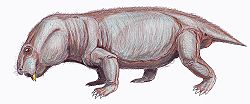| Emydopoidea Temporal range: Late Permian - Middle Triassic | |
|---|---|
 | |
| Restoration of the emydopoid Myosaurus gracilis | |
| Scientific classification | |
| Domain: | Eukaryota |
| Kingdom: | Animalia |
| Phylum: | Chordata |
| Clade: | Synapsida |
| Clade: | Therapsida |
| Suborder: | † Anomodontia |
| Clade: | † Dicynodontia |
| Clade: | † Therochelonia |
| Superfamily: | † Emydopoidea Cluver and King, 1983 |
| Subgroups | |
Emydopoidea is a group of Late Permian dicynodont therapsids. It includes the small-bodied Emydops , Myosaurus , and kingoriids, and the burrowing cistecephalids. [1]





